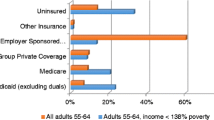ABSTRACT
Democrats and Republicans have turned to the concept of “high-risk pools” to provide health care for those Americans who face the dual challenge of uninsurance and serious health difficulties. Under the Patient Protection and Affordable Care Act (PPACA), these “high-risk” individuals will receive extensive help and regulatory protections, in concert with a new system of health insurance exchanges. However, these federal provisions do not become operational until 2014. As an interim measure, PPACA provides $5 billion for temporary, federally funded high-risk pools, now known as the Pre-Existing Condition Insurance Plan (PCIP). This analysis explores the adequacy of such funding. Using 2005/06 data from the National Health and Nutrition Examination Survey (NHANES), we find that approximately 4 million uninsured Americans have been diagnosed with emphysema, diabetes, stroke, cancer, congestive heart failure, angina, or a heart attack. To provide adequate health care for uninsured individuals with chronic diseases, the federal PCIP appropriations would need to be many times higher than either Democrats or Republicans have proposed.
Similar content being viewed by others
References
KFF.org. Side-by-side comparison of major health reform proposals. Kaiser Family Foundation. Available at: http://www.kff.org/healthreform/upload/housesenatebill_final.pdf. Accessed August, 2010.
Elmendorf D. Letter to Honorable John A. Boehner. Congressional Budget Office. Available at: http://www.cbo.gov/ftpdocs/107xx/doc10705/hr3962amendmentBoehner.pdf. Accessed August, 2010.
Pollack H. Stay away from that pool. New Republic. Available at: http://www.tnr.com/blog/the-treatment/more-those-high-risk-pools. Accessed August, 2010.
Buchmueller T, Glied SA, Royalty A, Swartz K. Cost and coverage implications of the McCain plan to restructure health insurance. Health Aff. 2008;27(6):W472–81.
GAO. Health Insurance: Enrollment, Benefits, Funding, and Other Characteristics of State High-Risk Health Insurance Pools. Washington, DC: Government Accountability Office; 2009. GAO-09-730R.
Frakt AB, Pizer SD, Wrobel MV. High-risk pools for uninsurable individuals: recent growth, future prospects. Health Care Financ Rev. 2004;26(2):73–87.
Stearns SC, Mroz TA. Premium increases and disenrollment from state risk pools. Inquiry. 1995;32(4):392–406.
Pizer SD, Frakt AB, Iezzoni LI. Uninsured adults with chronic conditions or disabilities: gaps in public insurance programs. Health Aff. 2009;28(6):W1141–50.
Stearns SC, Slifkin RT, Thorpe KE, Mroz TA. The structure and experience of state risk pools: 1988–1994. Med Care Res Rev. 1997;54(2):223–38.
Sloan FA, Conover CJ. Effects of state reforms on health insurance coverage of adults. Inquiry. 1998;35(3):280–93.
Sebelius K. Letter to Congressional Leaders. Department of Health and Human Services. Available at: http://www.politico.com/static/PPM153_sebelius_051010.html. Accessed August, 2010.
McWilliams JM, Meara E, Zaslavsky AM, Ayanian JZ. Differences in control of cardiovascular disease and diabetes by race, ethnicity, and education: US trends from 1999 to 2006 and effects of medicare coverage. Ann Intern Med. 2009;150(8):505–W590.
McWilliams JM, Meara E, Zaslavsky AM, Ayanian JZ. Health of previously uninsured adults after acquiring medicare coverage. JAMA, J Am Med Assoc. 2007;298(24):2886–94.
McWilliams JM, Meara E, Zaslavsky AM, Ayanian JZ. Intensity of health services and costs of care for previously uninsured medicare beneficiaries. J Gen Intern Med. 2007;22:67–8.
McWilliams JM, Zaslavsky AM, Meara E, Ayanian JZ. Impact of medicare coverage on basic clinical services for previously uninsured adults. JAMA, J Am Med Assoc. 2003;290(6):757–64.
DeNavas-Walt C, Proctor BD, Lee CH. Income, Poverty, and Health Insurance Coverage in the United States: 2005. Unted States Census Bureau. Available at: http://www.census.gov/prod/2006pubs/p60-231.pdf. Accessed August, 2010.
Holz-Eakin D. The uninsured and rising health insurance premiums. Congressional Budget Office. Available at: http://www.cbo.gov/doc.cfm?index = 5152&type = 0. Accessed August, 2010.
Schwartz T. State High-Risk Pools: Kaiser Commission on Medicaid and the Uninsured; January 2010 2010. 8041.
Merlis M. Health coverage for the high-risk uninsured: policy options for design of the temporary high-risk pool. National Institute for Health Care Reform. Available at: http://www.nihcr.org/High-RiskPools.html. Accessed August, 2010.
IOM. Public Financing and Delivery of HIV/AIDS Care. Washington, DC: National Academies Press; 2005.
Baucus M. Call to Action: Health reform 2009. United States Senate Finance Committee. Available at: http://finance.senate.gov/download/?id = 916b0ea3-96 dc-4c7a-bb35-241fa822367e. Accessed August 9, 2010.
Boltri JM, Okosun IS, Davis-Smith M, Vogel RL. Hemoglobin A(1C) levels in diagnosed and undiagnosed Black, Hispanic, and White persons with diabetes: Results from NHANES 1999-2000. Ethn Dis. 2005;15(4):562–7.
Plantinga L, Crews D, Coresh J, et al. Prevalence of chronic kidney disease is high in persons with undiagnosed or pre-diabetes in the United States. Am J Kidney Dis. 2009;53(4):160.
Rosen H, Saleh F, Lipsitz S, Rogers SO, Gawande AA. Downwardly mobile the accidental cost of being uninsured. Arch Surg. 2009;144(11):1006–11.
Nichols AL, Zeckhauser RJ. Targeting transfers through restrictions on recipients. Am Econ Rev. 1982;72(2):372–8.
McWilliams JM. Health consequences of uninsurance among adults in the United States: recent evidence and implications. Milbank Q. 2009;87(2):443–94.
Pollack H. The Cost of Delayed Reform. American Prospect. Available at: http://www.prospect.org/cs/articles?article = the_cost_of_delayed_reform. Accessed August, 2010
Funding
University of Chicago, Center for Health Administration Studies
Conflict of Interest
None disclosed.
Author information
Authors and Affiliations
Corresponding author
Rights and permissions
About this article
Cite this article
Pollack, H.A. High-Risk Pools for the Sick and Uninsured Under Health Reform: Too Little and Thus Too Late. J GEN INTERN MED 26, 91–94 (2011). https://doi.org/10.1007/s11606-010-1490-y
Published:
Issue Date:
DOI: https://doi.org/10.1007/s11606-010-1490-y




